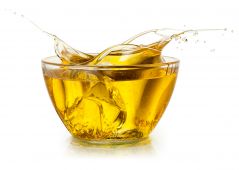Fats and oils: emulsification

An emulsion can be defined as a mixture of oily and watery liquids. To make an emulsion you need an emulsifier and force such as whisking and beating to break the oil droplets apart so they mix with the watery liquid.
There are two types of emulsions. The first is when water gets dispersed into fat/oil (such as butter, margarine or chocolate) and the second is when oil/fat gets dispersed in water (such as milk, mayonnaise, or salad dressing).
How do you form an emulsion?
If you add a drop or two of oil to water you can see that it does not dissolve or combine with the water: the oil floats on the water. If you shake the oil and water together then the oil breaks up into tiny droplets and becomes distributed in the water forming a mixture. However the mixture is unstable and if you left it for a while it would soon separate out into water and oil layers again.
To prevent the mixture from separating substances called emulsifiers can be added. These help to form and stabilise the emulsions, preventing or slowing the water and fat/oil from separating.
How do emulsifiers work?
Emulsifier molecules work by having a hydrophilic end (water-loving) and hydrophobic end (water-hating). The hydrophilic end of the emulsifier molecule is attracted to the water and the hydrophobic end is attracted to the fat/oil. By vigorously mixing the emulsifier with the water and fat/oil, a stable emulsion can be made.
Commonly used emulsifiers include egg yolk, or mustard. Emulsions are thicker than either the water or of fat/oil they contain, which is a useful property for some foods.
Explore
- In four glasses or test tubes place 2.5ml vinegar and 2.5ml oil
- Leave one glass or test tube as a control
- To the other glasses/test tubes add either
- 1g mustard powder
- 1g garlic paste
- 1g tomato paste
- In turn shake each of the four glasses or tubes and time using a stop watch how long it takes for the oil and vinegar to separate
- Which extra ingredient(s) makes the emulsion last longest?
- Can you think of any non-food emulsions (used in the bathroom for example)?
More information
Scottish Food and Drink Federatin (SFDF): Emulsions video


